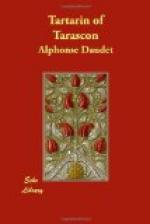After the Algeria of the native tribes which he had overrun, Tartarin of Tarascon became thence acquainted with another Algeria, not less weird and to be dreaded — the Algeria in the towns, surcharged with lawyers and their papers. He got to know the pettifogger who does business at the back of a cafe — the legal Bohemian with documents reeking of wormwood bitters and white neckcloths spotted with champoreau; the ushers, the attorneys, all the locusts of stamped paper, meagre and famished, who eat up the colonist body and boots — ay, to the very straps of them, and leave him peeled to the core like an Indian cornstalk, stripped leaf by leaf.
Before all else it was necessary to ascertain whether the lion had been killed on the civil or the military territory. In the former case the matter regarded the Tribunal of Commerce; in the second, Tartarin would be dealt with by the Council of War: and at the mere name the impressionable Tarasconian saw himself shot at the foot of the ramparts or huddled up in a casemate-silo.
The puzzle lay in the limitation of the two territories being very hazy in Algeria.
At length, after a month’s running about, entanglements, and waiting under the sun in the yards of Arab Departmental offices, it was established that, whereas the lion had been killed on the military territory, on the other hand Tartarin was in the civil territory when he shot. So the case was decided in the civil courts, and our hero was let off on paying two thousand five hundred francs damages, costs not included.
How could he pay such a sum?
The few piashtres escaped from the prince’s sweep had long since gone in legal documents and judicial libations. The unfortunate lion-destroyer was therefore reduced to selling the store of guns by retail, rifle by rifle; so went the daggers, the Malay kreeses, and the life-preservers. A grocer purchased the preserved aliments; an apothecary what remained of the medicaments. The big boots themselves walked off after the improved tent to a dealer of curiosities, who elevated them to the dignity of “rarities from Cochin-China.”
When everything was paid up, only the lion’s skin and the camel remained to Tartarin. The hide he had carefully packed, to be sent to Tarascon to the address of brave Commandant Bravida, and, later on, we shall see what came of this fabulous trophy. As for the camel, he reckoned on making use of him to get back to Algiers, not by riding on him, but by selling him to pay his coach-fare — the best way to employ a camel in travelling. Unhappily the beast was difficult to place, and no one would offer a copper for him.
Still Tartarin wanted to regain Algiers by hook or crook. He was in haste again to behold Baya’s blue bodice, his little snuggery and his fountains, as well as to repose on the white trefoils of his little cloister whilst awaiting money from France. So our hero did not hesitate; distressed but not downcast, he undertook to make the journey afoot and penniless by short stages.




